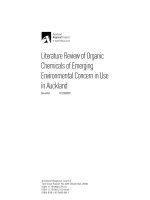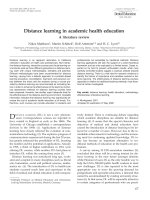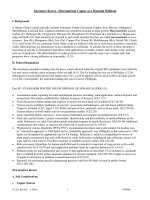Draft literature review, conceptual framework
Bạn đang xem bản rút gọn của tài liệu. Xem và tải ngay bản đầy đủ của tài liệu tại đây (248.86 KB, 9 trang )
THE UNIVERSITY OF DA NANG
VN - UK INSTITUTE FOR RESEARCH AND EXECUTIVE EDUCATION
Study Title:
ANALYSED MULTIFACETED DETERMINANTS THAT SHAPE CUSTOMER INTENTIONS
AND BEHAVIOUR TOWARD ECO - FRIENDLY COSMETICS: THE CASE OF VIETNAMESE
MARKET
A report submitted to the business department in partial fulfilment for final assessment for the module
Business Research Methods
Chief Investigator:
Kỳ Đỗ Hồng Uyên
Student ID:
20010004
Academic Supervisor:
Dr. Nguyen Thi My Huong
Institutional affiliation:
VNUK - Institute for Research and Executive
Education, The University of Da Nang
Confidentiality Statement
This document contains confidential information that must not be disclosed to anyone other than the
instructor and the student unless authorised to do so.
JANUARY 2023
1
TABLE OF CONTENTS
SYNOPSIS
4
ABBREVIATIONS
4
1.
5
2.
3.
CHAPTER1. INTRODUCTION
1.1.
RESEARCH BACKGROUND
5
1.2.
RESEARCH PROBLEM
5
1.3.
RESEARCH QUESTIONS
6
CHAPTER 2. LITERATURE REVIEW
7
2.1.
Study Background
7
2.2.
Theory Relevant to Research Questions/Hypotheses.
7
2.3.
Current Empirical Literature Relevant to Research Questions/Hypotheses
7
2.4.
Conceptual framework and hypotheses
7
CHAPTER 3. RESEARCH DESIGN
8
3.1.
Overview
8
3.2.
Research Design
8
3.3.
Study Participants
8
3.4.
Questionnaire Design
8
3.5.
Measures
8
3.6.
Collection of Data
9
3.7.
Procedures
9
4.
CHAPTER 4. DATA ANALYSIS
10
5.
CHAPTER 5. RESULTS AND FINDINGS
11
6.
5.1.
Order of Presentation for Nomothetic Studies
11
5.2.
Statistical Analyses to Answer Research Questions/Hypotheses
11
5.3.
Organise Data into Tables and Figures
11
CHAPTER 6. DISCUSSION AND FUTURE STUDIES
12
6.1.
Summary
12
6.2.
Conclusions
12
6.3.
Limitations
12
6.4.
Recommendations for Future Research
12
PUBLICATION POLICY
13
REFERENCES
14
APPENDIX
15
APPENDIX A: STUDY FLOW CHART
15
APPENDIX B: AMENDMENT HISTORY
15
2
a. SYNOPSIS
It may be useful to include a brief synopsis of the study for quick reference. Complete information and, if
required, add additional rows.
Study Title
Internal ref. no. / short
title
Study Design
Study Participants
Planned Sample Size
Planned Study Period
Objectives
Outcome Measures
Primary
Secondary
b. ABBREVIATIONS
Define all unusual or ‘technical’ terms related to the project. Add or delete as appropriate to your study.
Maintain alphabetical order for ease of reference.
3
1. CHAPTER 1. INTRODUCTION
2. CHAPTER 2. LITERATURE REVIEW
2.1. Study Background
Eco - friendly cosmetic products
The preceding literature has employed various terminologies to explicate the concept of “green”, including
“environmentally friendly”, “environmentally responsible activities”, “pro - environmental consumption
behaviour”, and “sustainable” (Kim and Seock, 2019; Kautish et al., 2019; Taufique et al., 2017). According to
Ottman (1998, p.89), “eco - friendly products” are typically durable, non-toxic, made from recycled
materials, or minimally packaged. Some scholars have demonstrated that they are efficacious in promoting
environmental safety across their entire lifecycle (Maniatis, 2016) and are designed to mitigate harm to the
environment (Tomasin et al., 2013). Therefore, the existing literature suggests that eco - friendly products
offer greater benefits to the environment and can reduce harm compared to conventional products (Paul et
al., 2016). Furthermore, Hsu et al. (2017) proposed that effective development of eco - friendly products is
crucial to sustain business growth through environmentally - friendly strategies.
Eco - friendly cosmetics embody a multifaceted approach that prioritises environmental conservation,
pollution mitigation, responsible utilisation of non - renewable resources, and safeguarding biodiversity. In
essence, green cosmetics constitute a sophisticated synthesis of ecological principles, scientific
advancement, and ethical considerations, aimed at promoting sustainable consumption and minimising
ecological harm (Amberg, N., & Fogarassy, C., 2019). According to Lin et al. (2018), cosmetic products that
are eco-friendly are formulated with natural ingredients, and combined with carrier agents, preservatives,
surfactants, humectants, and emulsifiers that are also naturally occurring.
2.2. Theory Relevant to Research Questions/Hypotheses.
2.2.1. Theory of planned behaviour
This study adopts the theoretical framework of Ajzen's (1991) theory of planned behaviour (TPB) model to
explore the relationships between experimental variables and consumers' acceptance of and engagement in
ecological behaviour. TPB is an extension of the theory of reasoned action (TRA) (Ajzen, 1991), wherein
perceived behavioural control (PBC) is introduced as an additional dimension to determine behavioural
intention.
4
Figure 1. Theory of planned behaviour model (TPB model)
Figure 2. Theory of reasoned action model (TRA model)
The core argument of the theory of planned behaviour posits that human behaviour is the result of reasoned
decision-making rather than impulsive action and is influenced by attitude, subjective norm, and perceived
behavioural control, which in turn affect behavioural intentions. In other words, behavioural intentions are
the key drivers of human behaviour, which are shaped by attitude (the evaluation of the target behaviour),
subjective norms (judgments about others' potential attitudes toward the target behaviour), and perceived
behavioural control (the perceived ability to perform the target behaviour). This framework provides a
robust and comprehensive approach for investigating the factors that underlie individuals' ecological
behaviour.
The TPB model has been widely used in past research to explore consumers’ behaviour intentions, as
demonstrated by numerous studies (Chen et al.,2016; Paul et al., 2016). For example, Han et al. (2010)
applied the TPB model to investigate hotel customers’ intention to visit a green hotel, while other studies
(e.g, Moser, 2016; Nguyen et al., 2016) have used the TPB model to examine consumers’ acceptance and
engagement in green behaviour. Hsu et al. (2017) also used the TPB model, which accounted for the
moderating effects of country of origin and price sensitivity, to investigate consumer’s intentions to purchase
green skincare products. Han et al. (2010) found that the TPB model was superior to the theory of reasoned
action (TRA) model in predicting purchase intention. Therefore, this study also utilises the TPB model to
assess consumers’ purchasing intentions and behaviours of environmentally friendly cosmetics.
5
2.3. Current Empirical Literature Relevant to Research Questions/Hypotheses
c. Include in this section:
● i. literature relating to individual variables
● ii. literature relating to specific combination of variables (specifically examine background and
relevant background literature as shown in Figure 4.1) relevant to the dissertation
d. This should be more than a listing of studies. What common thread holds them together? Use
transitions to effectively tie one section with another.
e. Incorporate discussion of strengths/weaknesses of methodology in previous studies and which you
are building on/hoping to avoid/improve upon in your study.
2.3.1. Attitudes toward eco - friendly cosmetics and purchase intention
2.3.2. Subjective norms and purchase intention
2.3.3. Perceived behavioural control and purchase intention
2.3.4. Environmental concern and purchase intention
2.3.5. Price sensitivity and purchase intention
2.3.6. The perception of purchase intention and purchase behaviour
2.4. Conceptual framework and hypotheses
a. Provide the proposed conceptual framework.
b. The researcher will have a number of hypotheses depending on the conceptual framework
c. Hypotheses are declarative statements written in the expected or predicted direction (usually an
alternate hypothesis). Such hypotheses are called research, scientific, or theoretical hypotheses and
are written in the present tense.
d. Operationalize variables in this section.
Use headings and subheadings liberally to organise this section. Consider making a “concept map” of
relevant literature for organisational purposes (do not include in the dissertation text, however). This section
should be reflective of deductive reasoning; starting broadly and narrowing the focus as the chapter
progresses.
6
7
f. REFERENCE
Ajzen, I. (1991). The theory of planned behaviour. Organisational behaviour and human decision
processes, 50(2), 179-211.
Amberg, N., & Fogarassy, C. (2019). Green consumer behaviour in the cosmetics market. Resources,
8(3), 137.
Chen, S. C., & Hung, C. W. (2016). Elucidating the factors influencing the acceptance of green
products: An extension of theory of planned behaviour. Technological Forecasting and Social
Change, 112, 155-163.
Han, H., Hsu, L. T. J., & Sheu, C. (2010). Application of the theory of planned behaviour to green hotel
choice: Testing the effect of environmental friendly activities. Tourism management, 31(3), 325-334.
Hsu, C. L., Chang, C. Y., & Yansritakul, C. (2017). Exploring purchase intention of green skincare
products using the theory of planned behaviour: Testing the moderating effects of country of origin
and price sensitivity. Journal of retailing and consumer services, 34, 145-152.
Kautish, P., Paul, J., & Sharma, R. (2019). The moderating influence of environmental consciousness
and recycling intentions on green purchase behaviour. Journal of Cleaner Production, 228, 14251436.
Kim, S. H., & Seock, Y. K. (2019). The roles of values and social norms on personal norms and proenvironmentally friendly apparel product purchasing behaviour: The mediating role of personal
norms. Journal of Retailing and Consumer Services, 51, 83-90.
Lin, Y., Yang, S., Hanifah, H., & Iqbal, Q. (2018). An exploratory study of consumer attitudes toward
green cosmetics in the UK market. Administrative Sciences, 8(4), 71.
Maniatis, P. (2016). Investigating factors influencing consumer decision-making while choosing green
products. Journal of Cleaner Production, 132, 215-228.
Moser, A. K. (2016). Consumers' purchasing decisions regarding environmentally friendly products:
An empirical analysis of German consumers. Journal of Retailing and Consumer Services, 31, 389397.
Nguyen, T. N., Lobo, A., & Greenland, S. (2016). Pro-environmental purchase behaviour: The role of
consumers' biospheric values. Journal of Retailing and Consumer Services, 33, 98-108.
Ottman, J., & Books, N. B. (1998). Green marketing: opportunity for innovation. The Journal of
Sustainable Product Design, 60(7), 136-667.
Paul, J., Modi, A., & Patel, J. (2016). Predicting green product consumption using theory of planned
behaviour and reasoned action. Journal of retailing and consumer services, 29, 123-134.
Taufique, K. M. R., Vocino, A., & Polonsky, M. J. (2017). The influence of eco-label knowledge and
trust on pro-environmental consumer behaviour in an emerging market. Journal of Strategic
Marketing, 25(7), 511-529.
8
Tomasin, L., Pereira, G. M., Borchardt, M., & Sellitto, M. A. (2013). How can the sales of green
products in the Brazilian supply chain be increased?. Journal of Cleaner Production, 47, 274-282.
g. APPENDIX
a. APPENDIX A: STUDY FLOW CHART
Optional
b. APPENDIX B: AMENDMENT HISTORY
Amendment
No.
Protocol
Version
No.
Date
issued
Author(s) of changes
Details of Changes made
List details of all protocol amendments here whenever a new version of the protocol is produced. This is not
necessary prior to initial REC submission.
9









